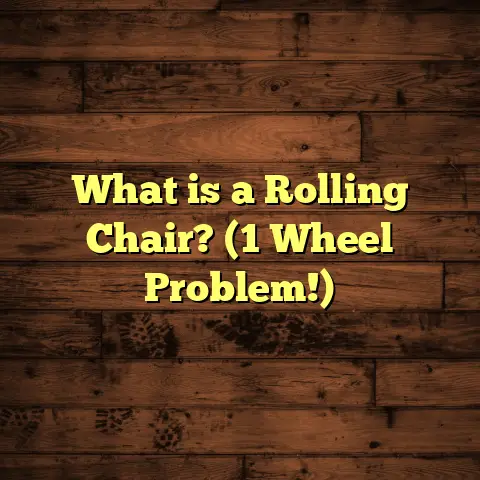Does Bona Make Floors Slippery? (5 Top Fixes!)
One question that keeps popping up is: “Does Bona make floors slippery?” It’s a common concern, and honestly, it deserves a good, thorough answer.
Let’s dive into this misconception together
and explore some real solutions for keeping
your floors safe and beautiful.
I’m here to
debunk the myths and give you practical tips
that actually work.
Keeping your floors safe is super important,
especially if you have kids or elderly family
members at home.
No one wants a slip-and-fall
accident!
So, let’s get started.
Section 1: Understanding Bona Products
Overview of Bona
Bona is a big name in the flooring world.
They’ve been around for ages, since 1919,
developing products for wood floor care.
They’ve built a solid reputation over the
years for quality and innovation.
I’ve personally used Bona products on countless jobs, and I can vouch for their effectiveness when used correctly.
Bona offers a wide range of products, including:
- Cleaners: Everyday cleaners for different
types of floors (hardwood, laminate, tile). - Finishes: Protective coatings to add shine
and durability to wood floors. - Sealers: Products that penetrate the wood
to protect it from moisture and damage.
Each product is designed with a specific purpose in mind, and choosing the right one is key to achieving the best results.
The Science Behind Bona’s Formulations
So, what’s the secret sauce?
Bona’s
formulations are designed to be effective
yet gentle on your floors.
They often use
water-based formulas that are low in VOCs
(volatile organic compounds), which is great
for indoor air quality.
The cleaners work by breaking down dirt and
grime without leaving behind a sticky residue.
The finishes contain polymers that create a
protective layer, guarding against scratches
and wear.
They also have non-slip additives.
Bona claims their finishes meet or exceed
industry standards for slip resistance.
For example, their Bona Traffic HD finish
is designed to provide excellent durability
and slip resistance, complying with standards
like ANSI A137.1.
Section 2: The Slipperiness Issue Explained
What Causes Slippery Floors?
Okay, let’s get to the root of the problem.
Why do floors become slippery in the first place?
Here are a few common culprits:
- Residue from Cleaning Products: Some cleaners
leave behind a film that can make floors slick. - Moisture: Water, spills, or even high
humidity can create slippery conditions. - Floor Texture: Smooth, polished floors are
naturally more slippery than textured ones.
Different flooring materials react differently
to cleaning products.
For example, laminate
floors can be more prone to slipperiness if
you use too much cleaner, while hardwood floors
might become slippery if the finish is worn
down.
Bona’s Impact on Different Flooring Types
Does Bona make all floors slippery?
Not necessarily.
It really depends on how
you use the product and what type of floor
you have.
- Hardwood: Bona’s hardwood floor cleaner
is generally safe and effective.
However, using too much cleaner or not
allowing the floor to dry properly can
lead to a slippery surface. - Laminate: Laminate floors can be a bit
more sensitive.
It’s crucial to use the
correct Bona product specifically designed
for laminate and to follow the instructions
carefully. - Tile: Bona’s tile and laminate cleaner
works well on tile, but again, proper
application is key.
I’ve talked to other flooring pros about this,
and the consensus is that Bona products are
safe and effective when used as directed.
However, user error is a common factor when
floors become slippery.
Section 3: Top 5 Fixes for Slippery Floors
Alright, let’s get down to brass tacks.
Here are my top 5 fixes for dealing with
slippery floors, even if you’re using Bona products:
Fix 1: Proper Cleaning Techniques
This is HUGE.
How you clean your floors makes
all the difference.
Here’s my step-by-step guide:
- Sweep or Vacuum: Always remove loose dirt
and debris before you start cleaning. - Dilute Properly: Follow the instructions
on the Bona product label for dilution ratios.
Using too much cleaner is a big no-no. - Use a Microfiber Mop: Microfiber mops are
gentle and effective at picking up dirt and
moisture. - Mop in Sections: Work in small sections,
applying the cleaner and then immediately
wiping it up with a clean part of the mop. - Let it Dry: Allow the floor to air dry
completely.
Don’t walk on it until it’s dry.
Fix 2: Using the Right Products for Your Floor Type
This might seem obvious, but it’s worth repeating.
Make sure you’re using the correct Bona product
for your specific floor type.
- Hardwood: Use Bona Hardwood Floor Cleaner.
- Laminate: Use Bona Laminate Floor Cleaner.
- Tile: Use Bona Stone, Tile & Laminate Floor Cleaner.
Using a pH-balanced cleaner is also important.
These cleaners are designed to be gentle on
your floors and won’t damage the finish.
Fix 3: Floor Preparation and Maintenance
Before you even start cleaning, it’s important to properly prepare your floors. This includes:
- Removing Old Finishes: If you’re applying
a new finish, make sure to remove any old,
worn-out finishes first. - Sanding (if necessary): If your hardwood
floors are heavily damaged, you might need
to sand them down before applying a new finish. - Cleaning Thoroughly: After sanding or
stripping, clean the floors thoroughly to
remove any dust or debris.
Fix 4: Utilizing Non-Slip Treatments
If you’re still concerned about slipperiness,
you can consider using a non-slip treatment.
These products are designed to increase traction
and reduce the risk of falls.
Some popular options include:
- Non-Slip Floor Coatings: These coatings
create a textured surface that provides
better grip. - Non-Slip Sprays: These sprays can be
applied to specific areas that are prone
to slipperiness. - Non-Slip Mats and Rugs: Strategically
placing mats and rugs in high-traffic areas
can also help prevent falls.
Fix 5: Regular Maintenance and Inspections
The best way to prevent slippery floors is to
establish a regular maintenance routine.
This
includes:
- Sweeping or Vacuuming Regularly: This will
remove loose dirt and debris that can contribute
to slipperiness. - Cleaning Spills Immediately: Wipe up spills
as soon as they happen to prevent them from
drying and becoming slippery. - Inspecting Your Floors: Regularly inspect
your floors for signs of wear and tear, such
as scratches or worn-out finishes.
I recommend inspecting your floors at least
once a month.
Pay close attention to high-traffic
areas, such as hallways and entryways.
Conclusion: Debunking the Myth
So, does Bona make floors slippery?
The answer
is a resounding no – when used correctly.
It’s all about proper cleaning techniques,
choosing the right products, and maintaining
your floors.
By following the tips I’ve shared, you can
keep your floors clean, beautiful, and safe
for everyone in your home.
Don’t let the
misconceptions scare you away from using
Bona products.
With a little knowledge and
care, you can achieve amazing results without
compromising safety.
Keep those floors sparkling and safe!





